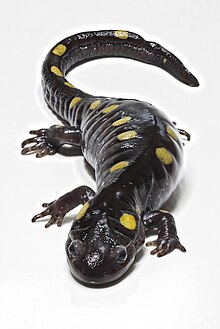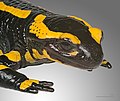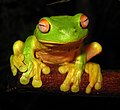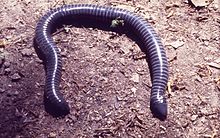User:The Transhumanist/Sandbox144
Introduction
Selected amphibian type
Salamanders are a group of amphibians typically characterized by their lizard-like appearance, with slender bodies, blunt snouts, short limbs projecting at right angles to the body, and the presence of a tail in both larvae and adults. All ten extant salamander families are grouped together under the order Urodela from the group Caudata. Urodela is a scientific Latin term based on the Ancient Greek οὐρά δήλη: ourà dēlē "conspicuous tail". Caudata is the Latin for "tailed ones", from cauda: "tail".
Salamander diversity is highest in eastern North America, especially in the Appalachian Mountains; most species are found in the Holarctic realm, with some species present in the Neotropical realm. Salamanders never have more than four toes on their front legs and five on their rear legs, but some species have fewer digits and others lack hind limbs. Their permeable skin usually makes them reliant on habitats in or near water or other cool, damp places. Some salamander species are fully aquatic throughout their lives, some take to the water intermittently, and others are entirely terrestrial as adults.
This group of amphibians is capable of regenerating lost limbs as well as other damaged parts of their bodies. Researchers hope to reverse engineer the regenerative processes for potential human medical applications, such as brain and spinal cord injury treatment or preventing harmful scarring during heart surgery recovery. The remarkable ability of salamanders to regenerate is not just limited to limbs but extends to vital organs such as the heart, jaw, and parts of the spinal cord, showing their uniqueness compared to different types of vertebrates. This ability is most remarkable for occurring without any type of scarring. This has made salamanders an invaluable model organism in scientific research aimed at understanding and achieving regenerative processes for medical advancements in human and animal biology. (Full article...)
Selected frog article
Poison dart frog (also known as dart-poison frog, poison frog or formerly known as poison arrow frog) is the common name of a group of frogs in the family Dendrobatidae which are native to tropical Central and South America. These species are diurnal and often have brightly colored bodies. This bright coloration is correlated with the toxicity of the species, making them aposematic. Some species of the family Dendrobatidae exhibit extremely bright coloration along with high toxicity — a feature derived from their diet of ants, mites and termites— while species which eat a much larger variety of prey have cryptic coloration with minimal to no amount of observed toxicity. Many species of this family are threatened due to human infrastructure encroaching on their habitats.
These amphibians are often called "dart frogs" due to the aboriginal South Americans' use of their toxic secretions to poison the tips of blowdarts. However, out of over 170 species, only four have been documented as being used for this purpose (curare plants are more commonly used for aboriginal South American darts) all of which come from the genus Phyllobates, which is characterized by the relatively large size and high levels of toxicity of its members. (Full article...)
Selected salamander article
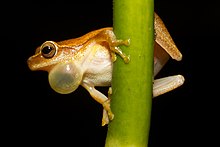
Sexual selection in amphibians involves sexual selection processes in amphibians, including frogs, salamanders and newts. Prolonged breeders, the majority of frog species, have breeding seasons at regular intervals where male-male competition occurs with males arriving at the waters edge first in large number and producing a wide range of vocalizations, with variations in depth of calls the speed of calls and other complex behaviours to attract mates. The fittest males will have the deepest croaks and the best territories, with females making their mate choices at least partly based on the males depth of croaking. This has led to sexual dimorphism, with females being larger than males in 90% of species, males in 10% and males fighting for groups of females.
There is a direct competition between males to win the attention of the females in salamanders and newts, with elaborate courtship displays to keep the females attention long enough to get her interested in choosing him to mate with. Some species store sperm through long breeding seasons, as the extra time may allow for interactions with rival sperm. (Full article...)
The page "User:The Transhumanist/Sandbox144/box-header" does not exist. The page "User:The Transhumanist/Sandbox144/DYK/5" does not exist.
Picture slideshow
Selected toad article

The toadstone, also known as bufonite (from Latin bufo, "toad"), is a mythical stone or gem that was thought to be found in the head of a toad. It was supposed to be an antidote to poison and in this it is like batrachite, supposedly formed in the heads of frogs. Toadstones were actually the button-like fossilised teeth of Scheenstia (previously Lepidotes), an extinct genus of ray-finned fish from the Jurassic and Cretaceous periods. They appeared to be "stones that are perfect in form" and were set by European jewellers into magical rings and amulets from Medieval times until the 18th century. (Full article...)
Selected caecilian article
Siphonops is a genus of caecilians in the family Siphonopidae, found in South America. All species are known to occur within Brazil, however, only S. hardyi and S. leucoderus are endemic to it. The native ranges of the other two known species, S. annulatus and S. paulensis, extend outwards into the surrounding countries of Argentina, Bolivia, and Paraguay. S. annulatus's range extends even further, stretching into Colombia, Ecuador, French Guiana, Guyana, Peru, Suriname, and Venezuela, and giving it perhaps the most widespread distribution of any single caecilian species.
Siphonops contains the following four species:
- Siphonops annulatus — ringed caecilian
- Siphonops hardyi — Hardy's caecilian
- Siphonops leucoderus — Salvador caecilian
- Siphonops paulensis — Boettger's caecilian, cutuchi (Full article...)
Categories
Topics
Related portals
Associated Wikimedia
The following Wikimedia Foundation sister projects provide more on this subject:
-
Commons
Free media repository -
Wikibooks
Free textbooks and manuals -
Wikidata
Free knowledge base -
Wikinews
Free-content news -
Wikiquote
Collection of quotations -
Wikisource
Free-content library -
Wikiversity
Free learning tools -
Wiktionary
Dictionary and thesaurus


